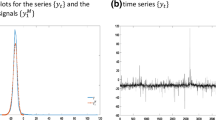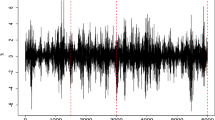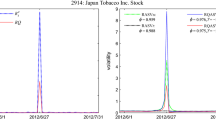Abstract
This paper generalizes the stochastic volatility model to allow for the double exponential jumps. To derive the jumps and time-varying volatility in returns, we implement an efficient Markov chain Monte Carlo approach based on the band and sparse matrix algorithms used in Chan and Hsiao (SSRN Electron J., 2013, https://doi.org/10.2139/ssrn.2359838) to estimate this model. We illustrate the the methodology using the daily data for the Shanghai Composite Index, Hangseng Index, Nikkei 225 Index and Kospi Index. We find that the stochastic volatility model with double exponential jumps provide better fitness in sample period.




Similar content being viewed by others
References
Asgharian, H., & Bengtsson, C. (2006). Jump Spillover in International Equity Mar kets. Journal of Financial Econometrics, 4(2), 167–203.
Bates, D. (1996). Jumps and stochastic volatility: Exchange rate processes implicit in Deutsche Mark options. Review of Financial Studies, 9, 69–107.
Boscher, H., Fronk, E. M., & Pigeot, I. (2000). Forecasting interest rates volatilities by GARCH (1,1) and stochastic volatility models. Statistical Papers, 41(4), 409–422.
Chan, J. C. C., & Hsiao, C. Y. L. (2013). Estimation of Stochastic Volatility Models with Heavy Tails and Serial Dependence. SSRN Electronic Journal. https://doi.org/10.2139/ssrn.2359838.
Das, S. R., & Foresi, S. (1996). Exact Solutions for Bond and Option Prices with Systematic Jump Risk. Review of Derivatives Research, 1, 7–24.
Engle, R. F. (1982). Autoregressive conditional heteroscedasticity with estimates of the variance of United Kingdom inflation. Econometrica, 50(4), 987–1007.
Eraker, B., Johannes, M., & Polson, N. (2003). The impact of jumps in voltility and returns. Journal of Finance, 58(3), 1269–1300.
Fuh, C. D., Luo, S. F., & Yen, J. F. (2013). Pricing discrete path-dependent options under a double exponential jump-diffusion model. Journal of Banking and Finance, 37, 2702–2713.
Heynen, R. C., & Kat, H. M. (1994). Volatility prediction: A comparison of stochastic volatility, GARCH(1,1) and EGARCH(1,1) models. The Journal of Derivatives, 2(2), 50–65.
Jacquier, E., Polson, N. G., & Rossi, P. E. (1994). Bayesian analysis of stochastic volatility models. Journal of Business and Economic Statistics, 12(4), 371–417.
Johannes, M., Kumar, R. and Polson, N. (1999). State Dependent Jump Models: How do U.S. Equity Markets Jump? Working Paper.
Kou, S. G. (2002). A jump diffusion model for option pricing. Management Science, 48(8), 1086–1101.
Kou, S. G., & Wang, H. (2004). Option pricing under a double exponential jump diffusion model. Management Science, 50, 1178–1192.
Li, H., Wells, M., & Yu, C. (2008). A bayesian analysis of return dynamics with levy jumps. Review of Financial Studies, 21, 2345–2378.
Chan, Joshua C. C., & Grant, Angelia L. (2016). Modeling energy price dynamics: GARCH versus stochastic volatility. Energy Economics, 54, 182–189.
Numatsi, A., & Rengifo, E. W. (2010). Stochastic volatility model with jumps in returns and volatility: An R-Package implementation. Lecture Notes in Statistics, 196, 191–201.
Yu, J. (2002). Forecasting volatility in the New Zealand stock market. Applied Financial Economics., 12(3), 193–202.
Ramezani, C. A., & Zeng, Y. (2007). Maximum likelihood estimation of the double exponential jump-diffusion process. Annals of Finance, 3(4), 487–507.
Scott, L. (1997). Pricing stock options in a jump-diffusion model with stochastic volatility and interest rates: Applications of Fourier inversion methods. Mathematical Finance, 7, 413–426.
Taylor, S. J. (1986). Modeling Financial Time Series. New York: John Wiley.
Author information
Authors and Affiliations
Corresponding author
Additional information
Publisher's Note
Springer Nature remains neutral with regard to jurisdictional claims in published maps and institutional affiliations.
Appendix A
Appendix A
In this section, we focus on sampling from the conditional posterior \(p(h|\Theta ,J,Z,Y)\) following Chan and Hsiao (2013). Since
we first derive the conditional densities \(p(Y|\Theta , h, J, Z)\) and \(p(h|\Theta )\). Equation (2) can be written as
and let \(H_{\phi _h}\) be a lower triangular matrix:
Then (14) can be expressed by matrix:
where \(\tilde{\delta _h}=(\mu _h, (1-\phi _h)\mu _h, \ldots , (1-\phi _h)\mu _h)'\), \(\Sigma _h=\mathrm{diag}(\frac{\sigma _h^2}{1-\phi _h^2}, \sigma _h^2, \ldots , \sigma _h^2).\) Hence we have \((h|\Theta )\sim N(\delta _h, (H_{\phi _h}'\Sigma _h^{-1}H_{\phi _h})^{-1})\), where \(\delta _h =H_{\phi _h}^{-1}\tilde{\delta _h}\). Then its log-density is
where \(c_1\) is a constant independent of h. On the other hand,
and
We can compute
where \({\tilde{h}}_t\) is chosen to be the mode of \(p(h|\Theta ,J,Z,Y)\). Then the second order Taylor expansion of \(\log p(y_t|\Theta , h_t, J_t, Z_t)\) at point \({\tilde{h}}\) is
where \(c_2\) is a constant independent of h, \(f=(f_1, \ldots , f_T)'\), and \(G=(G_1, \ldots , G_T)'\). Lastly, combining (16) and (19), we have
where \(c_3\) is a constant independent of h, \(K_h=H_{\phi _h}'\Sigma _h^{-1}H_{\phi _h}+G\), and \(k_h=f+G{\tilde{h}}+H_{\phi _h}'\Sigma _h^{-1}H_{\phi _h}\delta _h\). Therefore, \(h|_{\Theta ,J,Z, Y}\sim N({\hat{h}}, K_h^{-1})\), where \({\hat{h}}=K_h^{-1}k_h.\) Because \(K_h\) is a band matrix, \({\hat{h}}\) can be computed quickly.
The estimations of other parameters \((\mu , \mu _h, \phi _h,\sigma _h^2)\) are the same as those of the standard stochastic volatility model. Their posterior distributions are as follows:
\(\bullet \) Posterior of \(\mu \). \(\mu \sim N({\hat{\mu }}, D_{\mu })\), where
\(\bullet \) Posterior of \(\mu _h\). \(\mu _h\sim N({\hat{\mu }}_h, D_{\mu _h})\), where
\(\bullet \) Posterior of \(\phi _h\). \(\phi _h\sim N(\hat{\phi _h}, D_{\phi _h})1(|\phi _h|<1)\), where
\(\bullet \) Posterior of \(\sigma _h^2\). \(\sigma _h^2\sim IG(\nu +\frac{T}{2}, {\hat{s}})\), where
Rights and permissions
About this article
Cite this article
Li, J. Bayesian estimation of the stochastic volatility model with double exponential jumps. Rev Deriv Res 24, 157–172 (2021). https://doi.org/10.1007/s11147-020-09173-1
Accepted:
Published:
Issue Date:
DOI: https://doi.org/10.1007/s11147-020-09173-1




